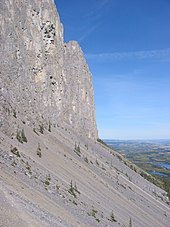
Back Tartera AN ركام حصى Arabic Ovuntu konusu Azerbaijani Сипей Bulgarian Tartera Catalan Osyp Czech Sgri Welsh Ur (geologi) Danish Talus (Geologie) German Lozŝtonejo Esperanto

Scree is a collection of broken rock fragments at the base of a cliff or other steep rocky mass that has accumulated through periodic rockfall. Landforms associated with these materials are often called talus deposits. Talus deposits typically have a concave upwards form, where the maximum inclination corresponds to the angle of repose of the mean debris particle size. The exact definition of scree in the primary literature is somewhat relaxed, and it often overlaps with both talus and colluvium.[1]
The term scree comes from the Old Norse term for landslide, skriða,[2] while the term talus is a French word meaning a slope or embankment.[3][4]
In high-altitude arctic and subarctic regions, scree slopes and talus deposits are typically adjacent to hills and river valleys. These steep slopes usually originate from late-Pleistocene periglacial processes.[5] Notable scree sites in Eastern North America include the Ice Caves at White Rocks National Recreation Area in southern Vermont and Ice Mountain in eastern West Virginia[6] in the Appalachian Mountains. Screes are most abundant in the Pyrenees, Alps, Variscan, Apennine, Orocantabrian, and Carpathian Mountains, Iberian peninsula, and Northern Europe.[7]
- ^ Landslides : investigation and mitigation. Turner, A. Keith, 1941-, Schuster, Robert L. Washington, D.C.: National Academy Press. 1996. ISBN 0-309-06208-X. OCLC 33102185.
{{cite book}}: CS1 maint: others (link) - ^ Harper, Douglas. "scree". Online Etymology Dictionary. Retrieved 2006-04-20.
- ^ Harper, Douglas. "talus". Online Etymology Dictionary. Retrieved 2008-12-01.
- ^ "Talus". bab.la language portal. Retrieved 2011-12-10.
- ^ Růžička, Vlastimil; Hajer, Jaromír (1996-12-01). "Spiders (Araneae) of stony debris in North Bohemia". Arachnologische Mitteilungen. 12: 46–56. doi:10.5431/aramit1202. ISSN 1018-4171.
- ^ Růžička, Vlastimil; Zacharda, Miloslav; Němcová, Lenka; Šmilauer, Petr; Nekola, Jeffrey C. (September 2012). "Periglacial microclimate in low-altitude scree slopes supports relict biodiversity". Journal of Natural History. 46 (35–36): 2145–2157. doi:10.1080/00222933.2012.707248. ISSN 0022-2933. S2CID 86730753.
- ^ Valachovič, Milan; Dierssen, Klaus; Dimopoulos, Panayotis; Hadač, Emil; Loidi, Javier; Mucina, Ladislav; Rossi, Graziano; Tendero, Francisco Valle; Tomaselli, Marcello (June 1997). "The vegetation on screes—A synopsis of higher syntaxa in Europe". Folia Geobotanica et Phytotaxonomica. 32 (2): 173–192. doi:10.1007/BF02803739. ISSN 0015-5551. S2CID 223142.